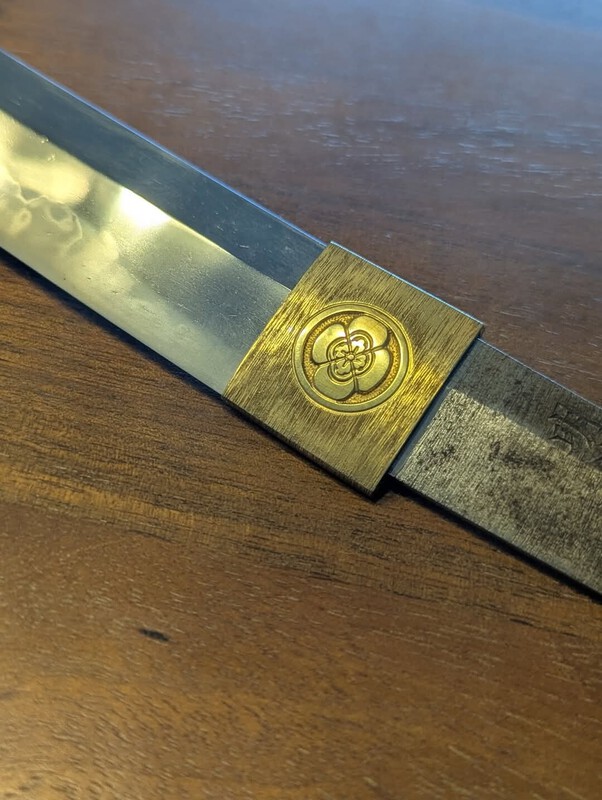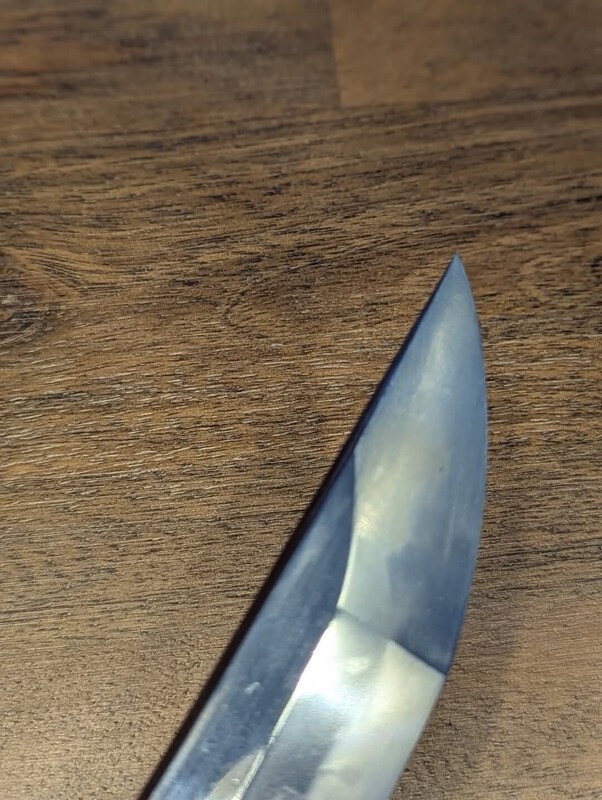-
Posts
5,069 -
Joined
-
Last visited
-
Days Won
135
Content Type
Profiles
Forums
Events
Store
Downloads
Gallery
Posts posted by Ray Singer
-
-
This is the WWII Seki smith Ishihara Kanenao. There are other examples of his work posted here on the discussion board, findable within search.
-
Appears to be a ken. I agree it looks shinshinto. The inscription of Amakuni likely is a reference to the famous early Yamato smith.
-
 1
1
-
-
-
Hi Steve, just to clarify this seems to be a different one from the example published. The same design, albeit with a thicker heaver execution. I would be inclined to leave as it is. Just my personal take, but I don't see it as being a detractor, and it am not sure that it would be easy to find someone to properly replicate the outer frame of the kozuka-ana as seen in the published example.
-
 5
5
-
-
Here is a link for that sword.
-
I use the term "umegane" here loosely. It really should only refer to metal inlaid into the blade as part of the repair process. In this case it appears that welding has been used to fill a void or flaw in the ji. The last place that I recall seeing this was an Enju daito, with a repair having the same appearance.
-
Unfortunately this looks very much like a welded "umegane" (a modern repair to fill a flaw in the blade). We've discussed the same type of feature here previously in another sword that was sold online.
-
 4
4
-
-
There are no individuals I know of who legitimately signed kikuichi during the Muromachi period. The fact as well that it is inscribed tachi-mei leans in that direction of a gimei kikusaku.
-
 2
2
-
-
Hi Jean, unfortunately I would not take this one too seriously. Looks like something intended to be passed off as a kikusaku (Gotoba collaboration work of the earliest Kamakura period).
Best regards,
Ray
-
 1
1
-
-
Nathaniel, please see below.
Nagasa: 75.7cm
Moto-haba: 35mm
Kasane: 8mm
Best regards,
Ray
-
 1
1
-
-
Apologies for the mistranslation. This does look like Nobumitsu as said above
-
 1
1
-
-
This appears to be Hiromitsu. Please see below.
-
 1
1
-
-
Hiromitsu
-
 1
1
-
 1
1
-
-
This powerfully formed katana is the work of Takano Masataka (real name: Takano Ken'ichi), forged to commemorate the 100th anniversary of the Meiji Restoration. Masataka, active during the Shōwa period, was born in 1891 in Ōme, Tokyo Prefecture. He was a disciple of Sakai Ikkansai Shigemasa.
MASATAKA (政賢), Shōwa (昭和, 1926-1989), Tōkyō – “Bushū Mitake-sanroku-jū Masataka” (武州御岳山麓住政賢), real name Takano Ken´ichi (高野賢一), he was born November 5th 1891 and studied under Sakai Ikkansai Shigemasa (酒井一貫斎繁政), he lived in the city of Ōmi (青梅) in Tōkyō Prefecture
This blade is a powerful piece in the Sō-den Bizen tradition, evoking the dynamic style of Chōgi. The blade is in polish with a high quality shirasaya and fitted with a beautifully executed gold-wash habaki bearing a kamon.
$7,250 + shipping & PP
-
 6
6
-
 2
2
-
-
Yes, the ninteisho attribution is to the Bungo smith Taira Nagamori.
-
-
Unfortunately tachi-mei of Munechika are, like the many mei we see of Masamune, often gimei of 'the big guy'. It may not be possible to place this with another swordsmith who legitimately used the name, and the fact that it is tachi-mei also points towards the idea that it was intended to be passed off as Sanjo Munechika.
-
 1
1
-
-
Agreed. Munechika.
-
 1
1
-
-
Hello all,
I am in the process of listing a number of newly received swords to my website, including several juyo katana in koshirae, and wanted to share a few recent highlights from my current consignment offerings, now live across both of my platforms: Swords of Japan and Nihon Art.
A few standouts now available:
-
Ashū Yokoyama Sukeyoshi kinnōtō
An impressive example of later Yokoyama work in kinnōtō form with long nagasa, wide mibaba and shallow sori with kanteisho and sayagaki.
🔗 https://nihonart.com/portfolio/ashu-sukeyoshi-kinnoto/
-
Bizen Osafune Yukikage Wakizashi – Tokubetsu Hozon
Beautiful ubu signed and dated early Muromachi wakizashi, with Tokubetsu Hozon, published in Fujishiro.
🔗 https://swordsofjapan.com/product/tokubetsu-hozon-bizen-osafune-yukikage-wakizashi/
-
Zaimei Kodai Kaneuji Wakizashi - Tokubetsu Hozon
Ubu signed ko-wakizashi by a later generation from the Mino Kaneuji lineage.
🔗 https://swordsofjapan.com/product/kodai-kaneuji-wakizashi/
-
Gakumei Oei Nobukuni Wakizashi – NBTHK Kanteisho & Tanobe Sayagaki
A masterful Yamashiro-den wakizashi with gakumei (inlaid signature) by Joshu (Oei) Nobukuni, featuring both NBTHK papers and Tanobe-sensei’s sayagaki.
🔗 https://swordsofjapan.com/product/joshu-nobukuni-wakizashi/
Additional pieces, including a Hosho Sadaoki, several Kasama Ikkansai + Horii school blades, and others are being added in the coming days. I’m always available to provide detailed photos, remote viewings, or further discussion on request. Feel free to reach out directly if you'd like to discuss any of these blades.
Warm regards,
Ray Singer
swordsofjapan.com | nihonart.com-
 3
3
-
-
I believe it is Noshu Seki ju Toshimasa saku
Research the WWII era smith who studied under Watanabe Kanenaga.
-
 2
2
-
 1
1
-
-
The mei is indeed Bizen (no) kuni Kanemitsu and does appear to be gimei. A missing boshi is not indicative of suriage, it points towards a kissaki that has been damaged and reshaped over time.
-
 3
3
-
 1
1
-
-
The mei is Bishu Osafune Morimitsu.
-
-
The nakago purports to be from a blade made in 1399. It looks generally legitimate for Oei Bizen. A reference for tsugi-nakago can be see in the list of flaws below.
https://www.sakuramatsuriantiquariato.com/en/valutare-una-spada-giapponese/difetti-nella-katana-giapponese/
An example of why someone would do this: someone in the past might have had a blade with a legitimate and important mei/nengo, on a blade that had a hagire or other significant issue. The nakago is welded to a healthier blade that may be close to the expected workmanship from the mei. So, as a form of deception the two are married together for resale.

































Mei translation
in Translation Assistance
Posted
https://www.google.com/search?q=ishihara+kanenao+site%3Awww.militaria.co.za&oq=Ishihara+Kanenao+&gs_lcrp=EgZjaHJvbWUqBggBECMYJzIMCAAQRRg5GIAEGKIEMgYIARAjGCcyBwgCEAAY7wUyCggDEAAYogQYiQUyBwgEEAAY7wUyBwgFECEYjwIyBwgGECEYjwLSAQgzMTQ0ajBqN6gCFLACAfEFoLNhfjuyH-jxBaCzYX47sh_o&client=ms-android-google&sourceid=chrome-mobile&ie=UTF-8